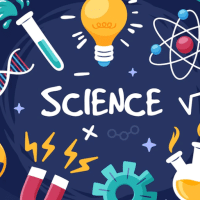Class 9 Exam > Class 9 Questions > Oxygen has three isotopes of atomic masses 16...
Start Learning for Free
Oxygen has three isotopes of atomic masses 16, 17 and 18 respectively. Explain the following: (i) They have same chemical properties. (b) Name the isotopes of hydrogen. (c) Give one point of similarity and one point of difference between isotopes 6 C12 and 6C14?
Most Upvoted Answer
Oxygen has three isotopes of atomic masses 16, 17 and 18 respectively....
Explanation of the given statements:
i) They have the same chemical properties:
Isotopes are atoms of the same element that have the same number of protons but different numbers of neutrons. The difference in the number of neutrons results in different atomic masses for the isotopes. However, the chemical properties of an element are determined by the number and arrangement of electrons in the atoms, rather than the number of neutrons.
The chemical properties of an element are determined by its electron configuration and the interactions of its electrons with other atoms. Since isotopes of an element have the same number of electrons and the same electron configuration, they exhibit the same chemical properties. This means that they have similar tendencies to form compounds, undergo chemical reactions, and participate in the same types of chemical bonds.
For example, all three isotopes of oxygen (O-16, O-17, and O-18) have the same number of electrons (8) and the same electron configuration (2 electrons in the first energy level and 6 electrons in the second energy level). As a result, they have the same chemical properties and can form similar compounds such as water (H2O) and carbon dioxide (CO2).
ii) Isotopes of Hydrogen:
Hydrogen has three isotopes, which are named based on their atomic masses:
1. Protium (symbol: H-1): It is the most common isotope of hydrogen and has an atomic mass of 1. It consists of a single proton and no neutrons.
2. Deuterium (symbol: H-2 or D): It is a stable isotope of hydrogen and has an atomic mass of 2. It consists of a proton and a neutron.
3. Tritium (symbol: H-3 or T): It is a radioactive isotope of hydrogen and has an atomic mass of 3. It consists of a proton and two neutrons.
iii) Similarity and Difference between Carbon-12 and Carbon-14:
1. Similarity: Both Carbon-12 and Carbon-14 are isotopes of carbon, meaning they have the same number of protons (6) and electrons. This results in similar chemical properties for both isotopes.
2. Difference: The main difference between Carbon-12 and Carbon-14 lies in their atomic masses, which are 12 and 14 respectively. This difference in atomic mass is due to the presence of different numbers of neutrons in the nucleus of each isotope. Carbon-12 has 6 neutrons, while Carbon-14 has 8 neutrons.
As a result of this difference in atomic mass, Carbon-14 is radioactive, meaning it undergoes radioactive decay over time. It is commonly used in radiocarbon dating to determine the age of organic materials, as its decay rate is known.
On the other hand, Carbon-12 is the most abundant and stable isotope of carbon and is used as the standard for atomic mass calculations.
In summary, isotopes of the same element have the same chemical properties due to their identical electron configurations. Hydrogen has three isotopes: Protium, Deuterium, and Tritium. Carbon-12 and Carbon-14 are isotopes of carbon with similar chemical properties but differ in their atomic masses and stability.
i) They have the same chemical properties:
Isotopes are atoms of the same element that have the same number of protons but different numbers of neutrons. The difference in the number of neutrons results in different atomic masses for the isotopes. However, the chemical properties of an element are determined by the number and arrangement of electrons in the atoms, rather than the number of neutrons.
The chemical properties of an element are determined by its electron configuration and the interactions of its electrons with other atoms. Since isotopes of an element have the same number of electrons and the same electron configuration, they exhibit the same chemical properties. This means that they have similar tendencies to form compounds, undergo chemical reactions, and participate in the same types of chemical bonds.
For example, all three isotopes of oxygen (O-16, O-17, and O-18) have the same number of electrons (8) and the same electron configuration (2 electrons in the first energy level and 6 electrons in the second energy level). As a result, they have the same chemical properties and can form similar compounds such as water (H2O) and carbon dioxide (CO2).
ii) Isotopes of Hydrogen:
Hydrogen has three isotopes, which are named based on their atomic masses:
1. Protium (symbol: H-1): It is the most common isotope of hydrogen and has an atomic mass of 1. It consists of a single proton and no neutrons.
2. Deuterium (symbol: H-2 or D): It is a stable isotope of hydrogen and has an atomic mass of 2. It consists of a proton and a neutron.
3. Tritium (symbol: H-3 or T): It is a radioactive isotope of hydrogen and has an atomic mass of 3. It consists of a proton and two neutrons.
iii) Similarity and Difference between Carbon-12 and Carbon-14:
1. Similarity: Both Carbon-12 and Carbon-14 are isotopes of carbon, meaning they have the same number of protons (6) and electrons. This results in similar chemical properties for both isotopes.
2. Difference: The main difference between Carbon-12 and Carbon-14 lies in their atomic masses, which are 12 and 14 respectively. This difference in atomic mass is due to the presence of different numbers of neutrons in the nucleus of each isotope. Carbon-12 has 6 neutrons, while Carbon-14 has 8 neutrons.
As a result of this difference in atomic mass, Carbon-14 is radioactive, meaning it undergoes radioactive decay over time. It is commonly used in radiocarbon dating to determine the age of organic materials, as its decay rate is known.
On the other hand, Carbon-12 is the most abundant and stable isotope of carbon and is used as the standard for atomic mass calculations.
In summary, isotopes of the same element have the same chemical properties due to their identical electron configurations. Hydrogen has three isotopes: Protium, Deuterium, and Tritium. Carbon-12 and Carbon-14 are isotopes of carbon with similar chemical properties but differ in their atomic masses and stability.
Attention Class 9 Students!
To make sure you are not studying endlessly, EduRev has designed Class 9 study material, with Structured Courses, Videos, & Test Series. Plus get personalized analysis, doubt solving and improvement plans to achieve a great score in Class 9.

|
Explore Courses for Class 9 exam
|

|
Similar Class 9 Doubts
Oxygen has three isotopes of atomic masses 16, 17 and 18 respectively. Explain the following: (i) They have same chemical properties. (b) Name the isotopes of hydrogen. (c) Give one point of similarity and one point of difference between isotopes 6 C12 and 6C14?
Question Description
Oxygen has three isotopes of atomic masses 16, 17 and 18 respectively. Explain the following: (i) They have same chemical properties. (b) Name the isotopes of hydrogen. (c) Give one point of similarity and one point of difference between isotopes 6 C12 and 6C14? for Class 9 2024 is part of Class 9 preparation. The Question and answers have been prepared according to the Class 9 exam syllabus. Information about Oxygen has three isotopes of atomic masses 16, 17 and 18 respectively. Explain the following: (i) They have same chemical properties. (b) Name the isotopes of hydrogen. (c) Give one point of similarity and one point of difference between isotopes 6 C12 and 6C14? covers all topics & solutions for Class 9 2024 Exam. Find important definitions, questions, meanings, examples, exercises and tests below for Oxygen has three isotopes of atomic masses 16, 17 and 18 respectively. Explain the following: (i) They have same chemical properties. (b) Name the isotopes of hydrogen. (c) Give one point of similarity and one point of difference between isotopes 6 C12 and 6C14?.
Oxygen has three isotopes of atomic masses 16, 17 and 18 respectively. Explain the following: (i) They have same chemical properties. (b) Name the isotopes of hydrogen. (c) Give one point of similarity and one point of difference between isotopes 6 C12 and 6C14? for Class 9 2024 is part of Class 9 preparation. The Question and answers have been prepared according to the Class 9 exam syllabus. Information about Oxygen has three isotopes of atomic masses 16, 17 and 18 respectively. Explain the following: (i) They have same chemical properties. (b) Name the isotopes of hydrogen. (c) Give one point of similarity and one point of difference between isotopes 6 C12 and 6C14? covers all topics & solutions for Class 9 2024 Exam. Find important definitions, questions, meanings, examples, exercises and tests below for Oxygen has three isotopes of atomic masses 16, 17 and 18 respectively. Explain the following: (i) They have same chemical properties. (b) Name the isotopes of hydrogen. (c) Give one point of similarity and one point of difference between isotopes 6 C12 and 6C14?.
Solutions for Oxygen has three isotopes of atomic masses 16, 17 and 18 respectively. Explain the following: (i) They have same chemical properties. (b) Name the isotopes of hydrogen. (c) Give one point of similarity and one point of difference between isotopes 6 C12 and 6C14? in English & in Hindi are available as part of our courses for Class 9.
Download more important topics, notes, lectures and mock test series for Class 9 Exam by signing up for free.
Here you can find the meaning of Oxygen has three isotopes of atomic masses 16, 17 and 18 respectively. Explain the following: (i) They have same chemical properties. (b) Name the isotopes of hydrogen. (c) Give one point of similarity and one point of difference between isotopes 6 C12 and 6C14? defined & explained in the simplest way possible. Besides giving the explanation of
Oxygen has three isotopes of atomic masses 16, 17 and 18 respectively. Explain the following: (i) They have same chemical properties. (b) Name the isotopes of hydrogen. (c) Give one point of similarity and one point of difference between isotopes 6 C12 and 6C14?, a detailed solution for Oxygen has three isotopes of atomic masses 16, 17 and 18 respectively. Explain the following: (i) They have same chemical properties. (b) Name the isotopes of hydrogen. (c) Give one point of similarity and one point of difference between isotopes 6 C12 and 6C14? has been provided alongside types of Oxygen has three isotopes of atomic masses 16, 17 and 18 respectively. Explain the following: (i) They have same chemical properties. (b) Name the isotopes of hydrogen. (c) Give one point of similarity and one point of difference between isotopes 6 C12 and 6C14? theory, EduRev gives you an
ample number of questions to practice Oxygen has three isotopes of atomic masses 16, 17 and 18 respectively. Explain the following: (i) They have same chemical properties. (b) Name the isotopes of hydrogen. (c) Give one point of similarity and one point of difference between isotopes 6 C12 and 6C14? tests, examples and also practice Class 9 tests.

|
Explore Courses for Class 9 exam
|

|
Suggested Free Tests
Signup for Free!
Signup to see your scores go up within 7 days! Learn & Practice with 1000+ FREE Notes, Videos & Tests.

























